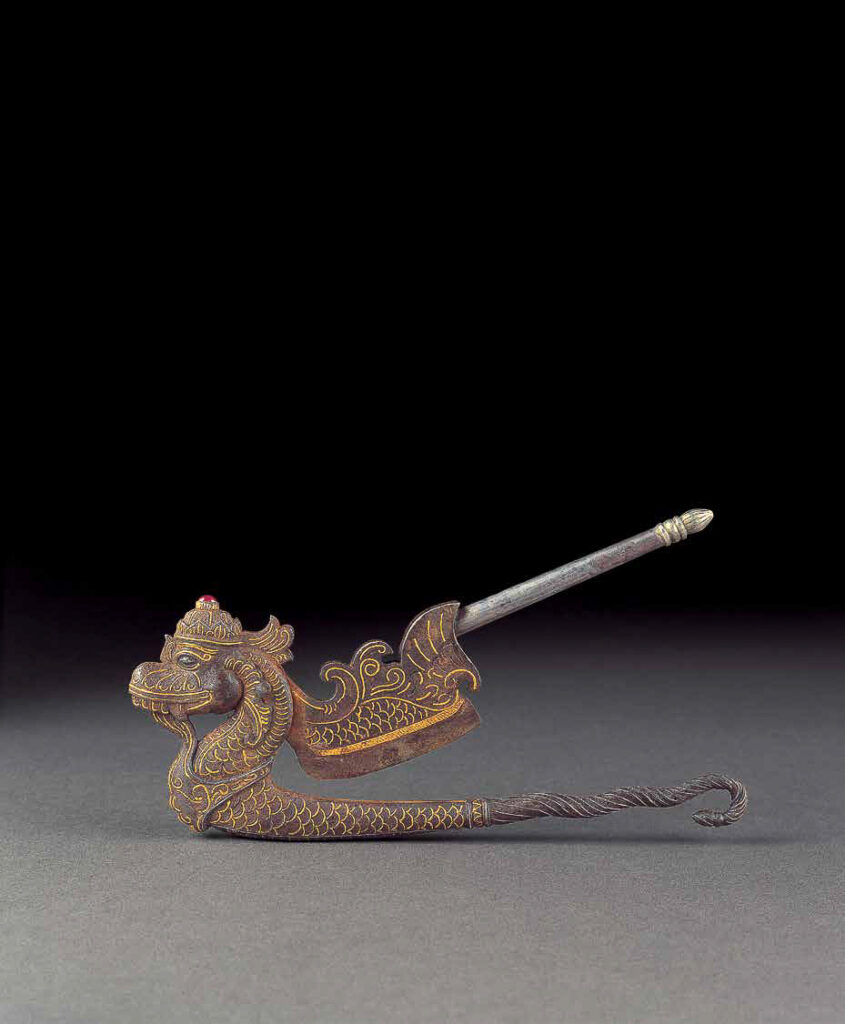
Kacip, betel nut cutter, gold, steel, Central Java. L: 15.5 cm. The Naga serpent deity holds an elevated position in traditional beliefs and is linked to the Underworld
Linda S. McIntosh writes about the story told by a quintessential Southeast Asian implement, the kacip betel nut cutter.
In her Thread and Fire: Textiles and Jewellery from the Isles of Indonesia and Timor, Linda S. McIntosh uses the extraordinary collection of Portuguese artist Francisco Capelo to represent the richness of material culture across the Indonesian archipelago. These objects reflect the pride of Indonesian royal courts in manifesting their splendour. This extract about the kacip betel nut cutter is an example of the unique meanings attached to objects in Indonesian culture.
The Naga, the ruler of the Underworld and a source of fertility, holds various roles in Javanese and, in general, Indonesian society. The Javanese melded indigenous beliefs of a serpent deity with the mythical Naga of India that originated from the fusion of fertility cults worshipping snakes with Hinduism and Buddhism. Nagas and their female complement, Nagis, rule the earth, sources of water, and the Underworld.
The embodiment of these deities materialized into the form of a snake, human, or hybrid of the two. After the adoption of Hinduism and Buddhism in the western Indonesian archipelago, including in the kingdoms of Java in the first millennium of the Common Era, the physical manifestation of the Naga followed its depiction in these world religions: the hooded king cobra. During the second millennium, an increase in the imports of Chinese ceramics to Indonesia occurred. Javanese and other Indonesian cultures transformed the Chinese dragon adorning ceramic jars, plates, and other items into local representations of the Naga. The transformative nature of this deity has remained constant despite Javanese society changing.
The Naga, the lord of the earth and Underworld, continued to be a royal figure in Javanese culture after Islam replaced Hinduism and Buddhism. Its image occurs in different art forms from batik, wayang puppetry, jewellery, to kacip or areca nut cutters.

Kacip Betel nut cutter, steel, inlaid gold, semiprecious stone, Central Java. L: 19.3 cm. The image of a crowned serpent deity or Naga also appears as a batik and weft ikat motif.
McIntosh, Linda S. 2019. Thread and Fire: Textiles and Jewellery from the Isles of Indonesia and Timor. River Books.
Author
 Researcher and curator Linda McIntosh received her doctorate from Simon Fraser University, Canada, and Masters of Arts degree from the University of Wisconsin-Madison. She is the author of several publications celebrating the textile culture of Southeast Asia, including Art of Southeast Asian Textiles: The Tilleke and Gibbins Collection and Thread and Fire: Textiles and Jewellery from the Isles of Indonesia and Timor, and is also a contributing editor to Textiles Asia. McIntosh recently redesigned the Xieng Khouang Museum in Laos.
Researcher and curator Linda McIntosh received her doctorate from Simon Fraser University, Canada, and Masters of Arts degree from the University of Wisconsin-Madison. She is the author of several publications celebrating the textile culture of Southeast Asia, including Art of Southeast Asian Textiles: The Tilleke and Gibbins Collection and Thread and Fire: Textiles and Jewellery from the Isles of Indonesia and Timor, and is also a contributing editor to Textiles Asia. McIntosh recently redesigned the Xieng Khouang Museum in Laos.


Comments
Could a naga/nagi be Indonesian, or is that a little off? I’m an artist, and I have a character who’s a nagi named Chaki U. Berbisa. I have a learning disability, but I want to add diverse representation to my artwork.